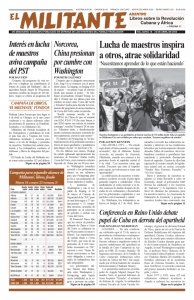OKLAHOMA CITY — “I’ve been here since last Monday and it just keeps growing,” Jimmy Acevedo, a teacher from Guymon in the Oklahoma Panhandle, told the Militant as we joined in protesting outside the state Capitol here April 9. “Teachers are on fire. We have to use the momentum to keep going, we won’t get this shot again.”
The uprising by teachers and school workers keeps rolling across the country, gaining in momentum and solidarity. Workers from other unions are joining in, hungry for a fight after decades of being pushed back and discounted by the capitalist rulers and their political parties in Congress and state Capitols.
In Oklahoma workers walked out April 2, determined to reverse years of declining wages and working conditions. The walkout is now in its second week. Thousands of teachers, other school workers and supporters hold daily rallies and marches outside the Capitol. Hundreds enter the building when the state legislature is in session, chanting “Fund our schools” and “We’re not leaving.”
Similar walkouts and mass teacher protests are taking place in Kentucky, where Gov. Matt Bevins has called teachers “thugs” and the legislature voted to eliminate pensions for new teachers. The Kentucky Education Association and local teachers’ groups have called for a mass protest at the Capitol April 13.
The Oklahoma legislature and Gov. Mary Fallon tried to defuse teachers’ anger and stave off the walkout at the last minute. On March 28, after months of claiming there was no money, legislators passed and Fallon signed a bill increasing annual wages for teachers by an average of $6,100, for staff by $1,250, for state workers by $750 to $2,000, and adding $50 million to school funding. This fell short of the demands by the teachers union, the Oklahoma Education Association. Teachers haven’t had a raise in over a decade. Fallon’s efforts failed to prevent the walkout.
And the bill imposed a slew of new taxes on personal consumption — like gas and tobacco — that fall hardest on working people.

‘Teacher Walkout — Time is Now!’
“When talking to West Virginia teachers, they told me the most important day of the walkout was the 2nd Monday,” posted Alberto Morejon April 9 on the Facebook group he set up, “Oklahoma Teacher Walkout – The Time is Now!” The
group now has over 70,000 members. Morejon started the group after watching the school workers’ walkout in West Virginia, a widely supported fight that won substantial pay raises for all state workers.
“They thought this would go away, but there are more people here today than last week,” said Rhonda Pruett, who has taught for three years in Lexington. “Now some superintendents have threatened to fire teachers.”

When the school board in the Western Heights Public Schools district here voted to limit support to one day, four of the teachers, including the former head of the high school English department, chose to resign and stay with the walkout.
Acevedo has been here since the first day of the walkout. He described the widespread support and solidarity they’ve gotten, both in the city and across the state.
“We’re getting so much donations that you don’t need to buy water or food,” he said. “The school cafeteria in Guymon is staying open to make sure students get meals. There have been local demonstrations in support of the teachers.”
Guymon, with a population of 11,000, is over four hours from Oklahoma City. It’s an oil town with a big slaughterhouse and a lot of agriculture. Acevedo grew up in a migrant family that moved from state to state following the harvests.
“A lot of immigrant workers have come there for jobs, 40 different languages are spoken in the town,” he said. “Recently there has been big influx of workers from Puerto Rico.”

Teachers from Inola, close to the Cherokee Reservation, filled seven vehicles and drove down to take part in the rally today. One of them said there had been public actions in support of the teachers there.
In Stillwater, volunteers report that donations of money, snacks, drinks and gas cards have come in every day since the walkout began.
The Capitol Hill High School here opened its field house April 8 for teachers living more than 60 miles away to stay at.
State officials’ efforts to pit the students against the teachers for walking out hasn’t worked. Big numbers of students attend the daily rallies. On April 4 they organized their own demonstration outside the Capitol to support the teachers.
Thousands of homemade signs graphically express workers’ opinions about the conditions they face. Adjusted for inflation, the state government’s funding for schools is down 28 percent per student since 2008. Buildings aren’t maintained, textbooks are a decade outdated and tattered, hallways aren’t heated and the lights are often turned off. Some 20 percent of the state’s school districts have moved to four-day weeks.
“In one year I can easily spend $1,000 myself on supplies for my class,” said Laura Hardee, who teaches at Putnam City Schools here. “Until this fight, the general public didn’t know how bad the school situation is. Teachers have picked up the slack for years.”
The Oklahoma Public Employees Association, the state workers union, also walked out April 2 and has encouraged members to join the rallies. The “raise the Legislature just passed won’t even cover the health insurance increases you’ve had to eat every year for the last five years,” the union said in a March 30 statement.
“Cuts in state services have been going on for 10 years,” said Kathleen Broudrick, who does food stamp and Medicaid certification for the Department of Human Resources in midwestern Oklahoma. “I have homeless clients who can’t get the medicine they need for mental problems. I make about $100 less a month than I did 10 years ago and pay more for health insurance.”
Teachers, parents and supporters of their fight organized a seven-day, 110-mile march from Tulsa to Oklahoma City, gaining support as they went. They arrived here April 10. When they marched up to the Capitol, thousands of teachers and other workers lined both sides of the streets, cheering so loudly it was deafening.
This reporter joined the march, carrying a sign saying, “Walmart workers support teachers, state workers.”
Since the march started, others have followed their example, starting early in the mornings and walking together to the daily rallies at the Capitol. Hundreds turned up here today, having marched from Edmond, 64 miles north of here. In a show of solidarity 50 students from U.S. Grant High School ran, walked and jogged eight miles to a rally here April 6.
Members of the Socialist Workers Party in New York and Philadelphia organized a team of workers to West Virginia April 5-8 to talk to workers in the coal fields about the school workers strike and victory there that helped kickoff the uprising across the country.
‘We need to be ready to do this’
“We went door to door in rural neighborhoods in Boone County in the south and Monongalia County in the north,” reported SWP member John Staggs from Philadelphia. “The support for the teachers’ fight was overwhelming and there was real pride among workers in general in how effectively they organized, stood together and won.”
Many West Virginia teachers said they were inspired by past United Mine Workers union battles that showed what a determined and disciplined fight could accomplish.
The team met three miners going into the night shift at the new Blackhawk mine. They said miners there had voted to go union, but the company had tied it all up in court. They said the teachers’ victory had them thinking they could do what the teachers did to get things moving.
“Going door to door talking to coal miners, construction workers, retirees and their family members was an amazing experience,” Craig Honts, who works on the Long Island Rail Road in New York, told the Militant. “One young construction worker said he was inspired by the teachers’ fight. ‘This is how you win — everyone stands together,’ he told me. ‘This is what we all need to be ready to do.’”


